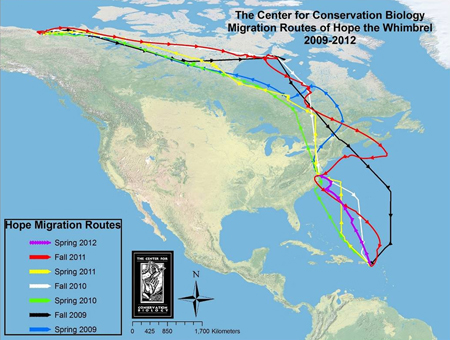In our last post we highlighted the Northern Waterthrush - a small bird frequently found in mangroves throughout the Caribbean that heavily relies on the boreal forest up north for summer breeding.

Hope, in her wintering grounds in St. Croix
Credit: Lisa Yntema
Another bird that shares such mangrove habitat and also heavily relies on the boreal for breeding (mostly near the Arctic and Hudson Bay coastlines) is the Whimbrel. This festive shorebird is known for its stocky figure, fearless defense of its nest and its long migratory journeys, not uncommonly exceeding 1,000 miles non-stop.
Whimbrels in particular have increasingly seen the public spotlight over the past few years thanks to a program outfitting Whimbrels with satellite tracking devices. This program has yielded great results and in helping to understand Whimbrel migration and behavior. We've blogged on several occasions about these birds, namely Hope (here and here), Machi and Goshen (here), who were unfortunately killed by hunters last year in Guadaloupe.
As saddening as the deaths of Machi and Goshen were, Hope seems to be embodying her name well. She's made three successful round trips back and forth between the Mackenzie River Delta and St. Croix so far and recently begun her spring trip back up to Canada, stopping in Virginia last week after a 1,600 mile, 60 hour flight from St. Croix.
You can see in Hope's migration map below that she is very loyal to her summer breeding grounds in the Mackenzie River Delta in Canada and wintering grounds of Great Pond (an Important Bird Area) in St. Croix in the Caribbean. She also appears to have several favored stopover habitats in Virginia and around Hudson Bay.
Here's a recent press release outlining some of her history and recent trip:
(Williamsburg, VA)---Hope, a whimbrel carrying a satellite transmitter, has returned to the Eastern Shore of Virginia after spending the winter on St. Croix in the U.S. Virginia Islands. The bird has been tracked by a team of researchers through her migratory travels since she was captured on Box Tree Creek in Northampton County, Virginia on 19 May, 2009. Since that time she has traveled more than 44,100 miles (71,000 kilometers) back and forth 3 times between breeding grounds on the MacKenzie River in western Canada and Great Pond Important Bird Area on St. Croix. She likely left Great Pond on the evening of April 1st and arrived in Virginia on the morning of April 4th, covering the 1600 miles in approximately 60 hours. She had been wintering on Great Pond since September 14, 2011.
Hope has taught the research community a great deal about the migratory pathways and habits of whimbrels. She has made tremendous nonstop flights, moved great distances out over the open Atlantic, confronted storms while at sea, navigated with precision to stopover sites and shown high fidelity to her breeding site, her wintering site, and several staging areas. Hope is one of more than a dozen birds that have been tracked in a collaborative effort between The Center for Conservation Biology, The Nature Conservancy and other partners designed to discover migratory routes that connect breeding and winter areas and to identify en route migratory staging areas that are critical to the conservation of this declining species.
Let's hope she continues to stay strong and healthy during the remainder of her trip back up north!
David


